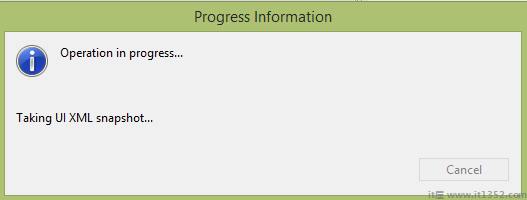在本章中,我们将介绍android屏幕的不同UI组件.本章还介绍了制作更好的UI设计的技巧,并解释了如何设计UI.
典型的用户界面Android应用程序包括操作栏和应用程序内容区域.
主要操作栏
查看控件
内容区域
拆分操作栏
这些组件也显示在下面的图像中 :

android应用程序的基本单元是活动. UI在xml文件中定义.在编译期间,XML中的每个元素都被编译成等效的Android GUI类,其属性由方法表示.
一个活动是由观点.视图只是屏幕上显示的小部件.它可以是按钮e.t.c.可以将一个或多个视图组合在一起成为一个GroupView. ViewGroup的示例包括布局.
布局有很多种类型.其中一些列在下面和下面;
线性布局
绝对布局
表格布局
框架布局
相对布局
线性布局进一步分为水平和垂直布局.这意味着它可以在单个列或单行中排列视图.下面是包含文本视图的线性布局代码(垂直).
<?xml version="1.0" encoding="utf-8"?> <LinearLayout xmlns:android="http://schemas.android.com/apk/res/android" android:layout_width="fill_parent" android:layout_height="fill_parent" android:orientation="vertical" > <TextView android:layout_width="fill_parent" android:layout_height="wrap_content" android:text="@string/hello" /> </LinearLayout>
AbsoluteLayout允许您指定其子项的确切位置.它可以这样声明.
<AbsoluteLayout android:layout_width="fill_parent" android:layout_height="fill_parent" xmlns:android="http://schemas.android.com/apk/res/android" > <Button android:layout_width="188dp" android:layout_height="wrap_content" android:text="Button" android:layout_x="126px" android:layout_y="361px" /> </AbsoluteLayout>
TableLayout将视图分组为行和列.它可以像这样声明.
<TableLayout xmlns:android="http://schemas.android.com/apk/res/android" android:layout_height="fill_parent" android:layout_width="fill_parent" > <TableRow> <TextView android:text="User Name:" android:width ="120dp" /> <EditText android:id="@+id/txtUserName" android:width="200dp" /> </TableRow> </TableLayout>
通过RelativeLayout,您可以指定子视图相对于彼此的位置.可以声明它像这样.
<RelativeLayout android:id="@+id/RLayout" android:layout_width="fill_parent" android:layout_height="fill_parent" xmlns:android="http://schemas.android.com/apk/res/android" > </RelativeLayout>
FrameLayout是屏幕上的占位符,可用于显示单个视图.它可以这样声明.
<?xml version="1.0" encoding="utf-8"?> <FrameLayout android:layout_width="wrap_content" android:layout_height="wrap_content" android:layout_alignLeft="@+id/lblComments" android:layout_below="@+id/lblComments" android:layout_centerHorizontal="true" > <ImageView android:src = "@drawable/droid" android:layout_width="wrap_content" android:layout_height="wrap_content" /> </FrameLayout>
除了这些属性外,还有其他属性在所有视图和ViewGroup中都很常见.它们列在下面和下面;
| Sr.No | View & description |
|---|---|
| 1 | layout_width 指定View或ViewGroup的宽度 |
| 2 | layout_height 指定View或ViewGroup的高度 |
| 3 | layout_marginTop 指定View或ViewGroup顶部的额外空间 |
| 4 | layout_marginBottom 指定额外空间在View或ViewGroup的底部 |
| 5 | layout_marginLeft 指定View或ViewGroup左侧的额外空间 |
| 6 | layout_marginRight 指定View或ViewGroup右侧的额外空间 |
| 7 | layout_gravity 指定子视图的定位方式 |
| 8 | layout_weight 指定布局中应将多少额外空间分配给视图 |
当您在Android UI上指定元素的大小时,您应该记住以下度量单位.
| Sr.No | Unit &安培; description |
|---|---|
| 1 | dp 与密度无关的像素. 1 dp相当于160 dpi屏幕上的一个像素. |
| 2 | sp 与比例无关的像素.这类似于dp,建议用于指定字体大小 |
| 3 | pt 点.根据物理屏幕尺寸,一个点被定义为1/72英寸. |
| 4 | px Pixel.对应屏幕上的实际像素 |
| Sr.No | Density& DPI |
|---|---|
| 1 | Low density 120 dpi |
| 2 | Medium density (mdpi) 160 dpi |
| 3 | High density (hdpi) 240 dpi |
| 4 | Extra High density (xhdpi) 320 dpi |
以下是创建高效布局的一些指导原则.
避免不必要的嵌套
避免使用太多的视图
避免深度嵌套